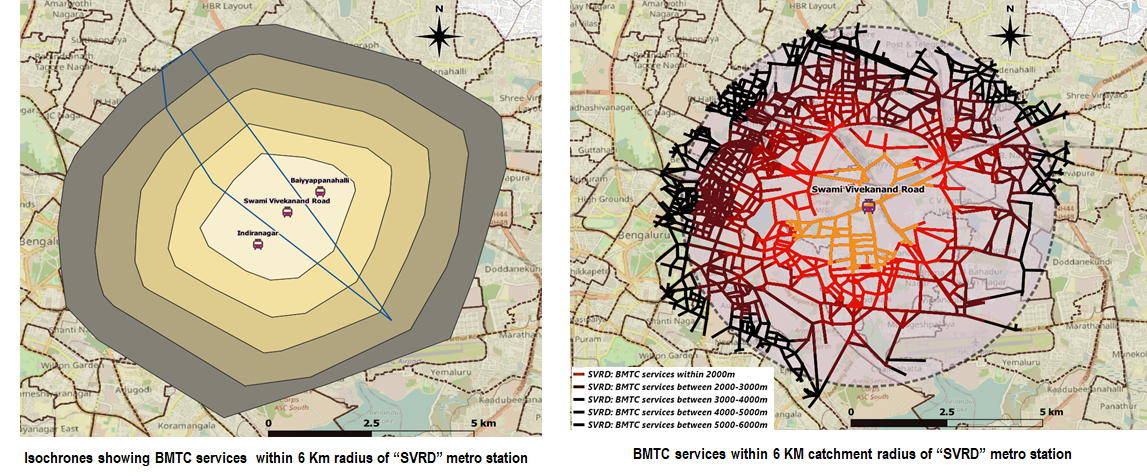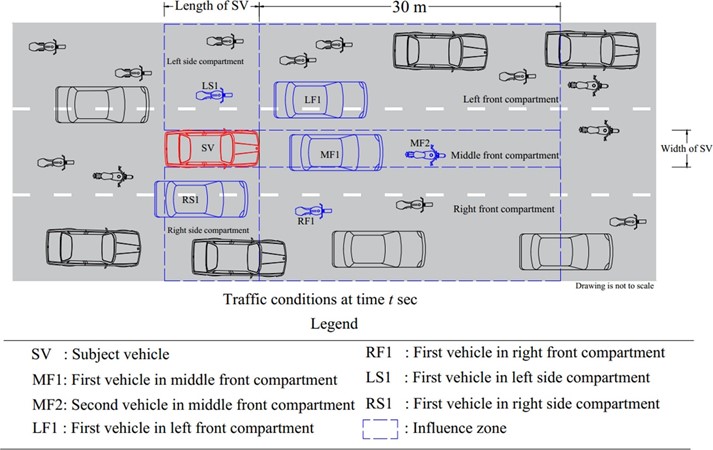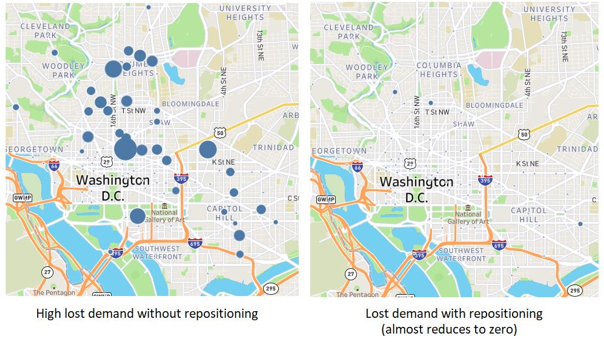Ongoing Research
PROJECTS ON PUBLIC TRANSIT
Improving Public Transit Systems
This study addresses multiple challenges related to public transit systems, like developing efficient journey planning algorithms and improving transit networks' reliability. Routing algorithms in transit networks are much more complicated than road networks due to their inherent time-dependent nature and the need for Pareto-optimization. We aim to improve bicritera (transfer and travel time) shortest path algorithms using graph theory concepts by modeling the transit networks as hypergraphs. Pareto-optimal solutions make transit network more attractive as it allows passengers a certain degree of freedom. The study also focuses on applications aspects of the routing algorithms like---measuring the difference between scheduled and actual timetable. Unreliability in transit networks caused due to this gap is the leading cause for declining transit ridership.
Solutions to Bus Bunching Problems
Bus bunching which causes multiple buses on a single route to group together is a major issue faced by most transit agencies. Such situations occur naturally when there are fluctuations in the network travel times or in passenger demand. Bus bunching results in crowding of the lead buses and affects the level of service of transit operations. Over the recent past, certain types of holding strategies have been found to be effective to counter this phenomenon. Specifically, these models calculate the optimal amount of time to wait at selected locations to equalize headways among all the buses serving a route. Such techniques have the potential to balance passenger load and improve reliability and ridership. A similar headway-equalizing mechanism is being developed to tackle this issue on BMTC’s buses in Bangalore.
Improving First- and Last-Mile Connectivity
This work aims to improve the first- and last-mile connectivity of public transit systems. We develop an agent- and event-based model using the software AnyLogic to simulate passenger arrival and the assignment of auto-rickshaws to first- and last-mile passengers. Auto-rickshaws and passengers are modelled as agents and their behaviour is described using statecharts. We analyse the entry and exit passenger demand data and metro train schedule of Bengaluru city along with the land use data. We also propose an optimization model to position auto-rickshaws at metro stations to minimize the number of unserved trip requests. We evaluate our model using various performance indicators including the percentage of lost demands, auto-rickshaw utilization, average round trip distance and the number of trips.
Ridership Prediction Models for Bus Transit Systems in Indian cities
Transit ridership forecasting models are valuable tools for transit agencies to assess and quantify the possible impacts of their operational strategies and service improvements on transit demand and farebox revenue. However, most Indian cities with large transit systems do not have access to reliable transit ridership forecasting models. This study develops a spatially disaggregate, direct demand model of bus transit ridership in Bengaluru, using ITS data from BMTC. Such a modelling tool can be used by bus transit agencies to forecast ridership changes due to various measures such as changes in routes, service frequency, schedules, bus fares, and connectivity to and from other modes of travel.
This study is among the first few attempts at developing comprehensive bus transit ridership forecasting models for Indian cities. The novelty of the study lies in addressing the following methodological and substantive issues associated with modelling transit demand: (i) endogeneity and non-linearity of the influence of service frequency with respect to ridership, (ii) spatial disaggregation of transit ridership from a fare-stage cluster level to individual stops although ridership data is typically available only at the former aggregation, (iii) rigorous treatment of the inter-route relationships in the transit network such as competition for passengers and complementarity among transit routes – both within the bus transit network and with the metro network, and (iv) the use of Voronoi polygons to resolve the issue of overlapping of bus-stop/metro-station catchment areas (as opposed to ad hoc subtraction of overlapping buffer areas). The proposed modelling framework, including the treatment of inter-route relationships, is general enough to be applicable to model transit ridership in cities of other countries as well.
Ridership Prediction Models for Metro Rail Systems in Indian cities
The objective of the proposed research is to develop an aggregate direct demand model of metro ridership to quantify the influence of internal and external factors on metro boardings and alightings for different time periods. Ridership changes due to changes in accessibility improvements, interactions within the bus transit network, and supply (seats per hour) will also be examined. Expected contributions include delivering a means to evaluate the impacts of accessibility improvements (walk access and transit access) on metro ridership. The research work also aims to provide a mechanism to identify the impacts of competing and complementary effects of bus transit network on metro ridership (cross interaction effects) and offer a mechanism to measure the impacts of changes in supply (no of seats per hour) on metro ridership and revenue.

Responses of policy-sensitive variables in short-term operational planning model for bus transit agencies
The purpose of this work is to develop a practical, short-term operational planning tool for bus transit agencies that incorporates an integrated model of transit demand, supply, and inter-route relationships within a single-model system. We examine the influence due to changes in service frequency, and headway variability on ridership and operation cost. For different time periods (day of the week and time of the day), we analyze ridership changes in long routes caused by headway variability owing to issues such as bus bunching and crowding versus ridership changes in shorter routes with fewer chances of variability in travel time but involve making transfers. We aim to provide a mechanism to identify the impacts of changes in service frequency (such as removing a trip from the actual schedule) on ridership and operation costs for a selected route for a given time period. Other contributions include a) quantifying the non-linear impacts of service frequency and headway variability on ridership and revenue to identify the most productive routes in a transit system; b). offer a means to recognize demand-supply feedback relationship that exists in very short time-frames such as the impact of headway variability (bus bunching) on crowding and cost of transfers on ridership.
On Disentangling Unfamiliarity from Informed Perceptions of Service Quality Attributes for Transit Usage in Bangalore, India
This study presents a model to shed light on the factors influencing individuals’ likelihood and frequency of usage of bus transit in Bengaluru, India, with a focus on the role of subjective perceptions of service quality. Generally, subjective perceptions such as comfort, cleanliness, reliability, and safety are measured in travel surveys using Likert scale questions. We hypothesize that transit non-users’ unfamiliarity about transit services could be confounded with informed neutral opinions of transit users. This is because, non-users, due to their ignorance of the transit environment, tend to give more neutral responses rather than giving a clear negative or positive rating. In order to disentangle unfamiliarity from informed perceptions, this study uses a generalized heterogeneous data model (GHDM) that allows the joint econometric analysis of individuals’ perceptions, unfamiliarity, and likelihood of transit use and extent of usage. Among the interesting results from this empirical study, we observe the importance of separating unfamiliarity from informed opinions, a need to revise Likert scale survey questions on perceptions to include an option for respondents to state unfamiliarity and informing policies for enhancing ridership that are relevant to specific market segments.
PROJECTS ON TRAFFIC OPERATIONS
Development of a Driving Simulator
An in-depth understanding of the nature of human driving is necessary to study traffic system dynamics, causes for accidents, and traffic congestion etc. and to propose effective solutions to mobility related problems. This understanding is usually acquired through driver behavioural studies that investigate specific aspects of driving. With the advent of high-end computing and virtual reality technologies, driving simulators are popularly being used for conducting such studies and have several advantages. For example, driving situations are controllable and reproducible, costs are lower, and there is no risk for subjects, all of which allow studying the effects of sleep deprivation, distraction, etc. on traffic. The simulator is an interactive system in which a ‘respondent’ drives an ‘animated vehicle’ in a computer-generated ‘traffic environment’. Although several driving simulators exist, little work has been done in generating the traffic environments that are close to real world driving behaviours. Moreover, most driving simulators are developed for evaluating the behaviours of only car drivers in lane-based environs. However, the traffic conditions in developing countries like India are characterised by multiple vehicle types (two-wheelers, auto-rickshaws, buses and trucks) and absence of lane discipline. Thus, the aim of this study is to develop a driving simulator capable of representing realistic traffic environs based on robust driver behaviour models and while handling multiple vehicle types and disordered traffic movements that is observed in Indian conditions.
Modelling driver behaviour for Indian traffic conditions

The study proposes a multi-vehicle anticipation-based discrete-continuous choice modelling framework to describe driver behaviour in heterogeneous disordered traffic streams. To incorporate multi-vehicle anticipation, the concept of an influence zone around a vehicle is introduced and assumed that vehicles within the influence zone potentially influence driving behaviour. The theoretical position of the study is confirmed through empirical application and simulation experiments.
PROJECTS ON SHARED MOBILITY
Cab Allocation and Routing
Cab aggregators commonly face the issue of matching ride requests to vehicles in near real-time. In addition to cab-hailing services such as Ola and Uber, this problem is also relevant to operations of popular food-delivery services such as Zomato and Swiggy. This topic can be addressed optimally in offline settings at least when the number of customers and cabs are reasonably small using a variety of pre-processing algorithms and integer programming. However, in practice, such decisions are made online when drivers are searching for passengers or are in the process of serving one or more customers. In this project, we address the problem of developing allocation and routing strategies that are adaptative and utilize future anticipated demand. The problem is currently addressed by minimizing the supply of cabs required with a penalty for lost trips and will be expanded to model other objectives. Several visualization tools for understanding the performance of the proposed models are also being developed using the New York City taxi data set.
Algorithms for rebalancing Bicycle Sharing Systems
Bike-sharing systems (BSSs) are emerging as a popular type of shared vehicle platform where users can rent bicycles without owning and maintaining them. In a station-based BSS, demand fluctuations cause shortages and excesses over time and result in customer dissatisfaction. This issue can be addressed by repositioning bicycles during the day. We model the dynamic rebalancing problem as a Markov Decision Process (MDP) and seek threshold policies for repositioning. The parameter values are tuned using a Deterministic Policy Gradient (DPG) algorithm. The proposed framework is tested on open data from Capital Bikeshare (CaBi) in Washington, D.C., USA.

PROJECTS ON TRANSPORTATION SAFETY
Using real-time feedback to enhance driver safety performance
Road traffic crashes are responsible for about 1.35 million fatalities and a minimum of 20 million injuries each year, draining about 3% of the world’s GDP as per WHO. About 93% of the road fatalities occur in low to middle-income countries with India at the top among 199 countries. Undoubtedly, India is facing enormous challenges in road safety. Driver error is one of the major causes of road crashes in India. We at CiSTUP aim to significantly reduce driver errors and fundamentally transform road safety management practice in India by making it proactive. To achieve this aim, the research team at CiSTUP is working on understanding the impact of real-time feedback provided using a driver assistance system on the driving behavior of bus drivers.
SITIS: Safe and Secure Transport Corridors in India
The platform called the Swedish Indian Transport Innovation and Safety Partnership (SITIS) was inaugurated at the 3rd UN Road Safety Conference in Stockholm. It comprises companies such as Volvo Group, Autoliv, SAAB, Tech Mahindra, Manipal Hospitals, and Altair; research institutes such as Chalmers, RISE, VTI, IIT-TRIPP, and IISc; and authorities such as ARAI and Swedish Administration Authority. They have all committed to working together in the next five years on improving traffic safety and efficiency in India through various projects. The objectives for the first pilot project are: to identify safety characteristics of intercity coach transportation for the given corridors; to explore methods to collect, store, and analyze relevant data in a cost-efficient manner; and to examine suitable services related to efficient transport solutions, security, and safety of passengers and drivers.

